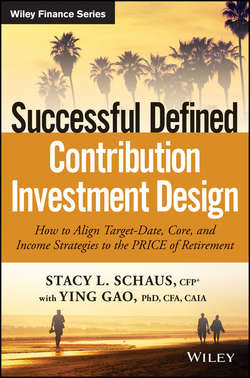Читать книгу Successful Defined Contribution Investment Design - Gao Ying - Страница 11
На сайте Литреса книга снята с продажи.
PART ONE
DC Plans: A Cornerstone of Retirement
CHAPTER 1
DC Plans Today: An Overview of the Issues
PREFACE: A CAREER AND A NEW FORM OF PENSION PLAN ARE BORN
ОглавлениеI started my career in 1981, at the age of 21.. which also happened to be the year 401(k) plans were launched. As a new employee at Merrill Lynch Capital Markets, I had the great fortune of working with financial professionals who immediately recognized the power of tax-deferred retirement investing. One experienced colleague told me, “If you participate in this plan, you’ll be a millionaire someday.” That’s all I needed to hear to sign up for automatic payroll deductions into my plan – a practice I have never stopped. Today, I am among the many millions of workers around the world who will fund retirement primarily with my defined contribution assets. I am very fortunate to have been advised to start saving early, and to have ignored others’ suggestions to postpone retirement savings and “enjoy being young.” I’m also lucky that I’ve had access to an employer-sponsored plan funded via automatic payroll deduction, and to have a healthy investment menu from which to choose.
In short, I’ve spent my working years with a defined contribution (DC) pension, versus the “traditional” defined benefit (DB) pension. I believe that my personal experience, as someone who started working just as 401(k) plans came into being, has helped me understand the power and importance of “getting DC right.” In 1989, I joined Hewitt Associates in Lincolnshire, Illinois, and shortly thereafter turned 100 percent of my professional focus toward consulting to DC plan sponsors and research, including creating the Hewitt 401(k) Index to track participant reaction to stock market movements. Since that time, and in the 10-plus years I’ve spent working at PIMCO, getting DC right has not only been a personal but also a professional passion. As my career is exactly as old as 401(k) plans, this means that DC plans and I have “grown up” together.
Part of growing up for DC plans has been the evolution toward more institutional structures, which some refer to as “DB-izing” DC. This movement includes shifting away from retail-priced packaged products, such as mutual funds and closed-architecture target-date funds, and toward collective investment trusts, separately managed accounts, and custom multi-manager structures. These shifts can be beneficial for plan participants: Using institutional investment vehicles and improving asset diversification may lower plan costs and improve risk-adjusted investment returns for participants. For example, if an investor could earn an additional 100 basis points (1 percent), over a 40-year career, this expense and return difference adds up. Indeed, for someone starting with a salary of $50,000 – and assuming annual real wage gains of 1 percent; contribution rates, including the employer match, of 9.5 percent (in the first 10 years) and 15.5 percent (for the next 30 years); and conservative portfolio returns of 4 percent per year – an additional portfolio return of 1 percent plus the reduction in expenses resulting from the shift from retail-priced products compounds after 40 years into about $210,000 when retirement starts. This extra sum may be sufficient to boost the retirement income replacement rate by 16 percent throughout retirement (that is, the extra sum can be used to provide yearly income in retirement that is equal to 16 percent of yearly preretirement pay).
To support the ongoing transition of DC plans toward more institutional structures, in 2010 I worked with Lew Minsky, Executive Director of the Defined Contribution Institutional Investment Association (DCIIA), to launch and serve as the founding Chair of this organization. DCIIA is a community of retirement leaders that is passionate about improving the retirement security of workers by improving the design and outcomes of DC plans. DCIIA brings together professionals from across the DC market, including consultants, asset managers, plan sponsors, recordkeepers, insurers, lawyers, communication firms, and others, all working together on this common goal.
Today, as DC plans are poised to become the dominant form of retirement savings around the world, I am inspired to provide a book to help guide the development of successful DC plans primarily for the benefit of employers and workers now and in the future. My hope is that plan sponsors, consultants, and other plan fiduciaries, by engaging with the materials in this book, will take away an empowering framework and insights to help structure and further evolve DC plan design.
